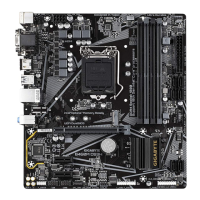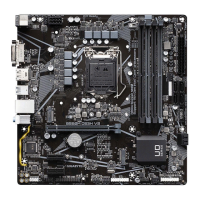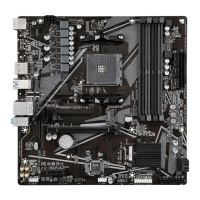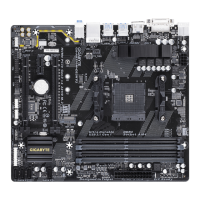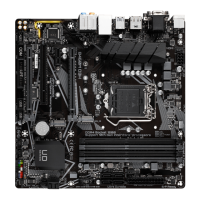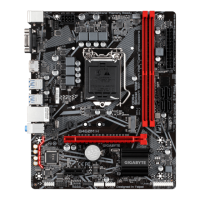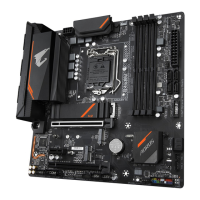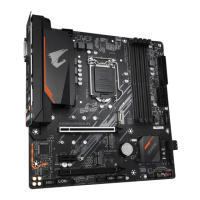Do you have a question about the Gigabyte B460M DS3H V2 and is the answer not in the manual?
| Processor socket | LGA 1200 (Socket H5) |
|---|---|
| Processor manufacturer | Intel |
| Compatible processor series | Intel Core i3, Intel Core i5, Intel Core i7, Intel Core i9 |
| ECC | Yes |
| Memory channels | Dual-channel |
| Memory slots type | DIMM |
| Number of memory slots | 4 |
| Supported memory types | DDR4-SDRAM |
| Maximum internal memory | 128 GB |
| Supported memory clock speeds | 2133, 2400, 2666, 2933 MHz |
| Supported memory module capacities | 4GB, 8GB, 16GB, 32GB |
| RAID levels | 0, 1, 5, 10 |
| Supported storage drive types | HDD & SSD |
| Supported storage drive interfaces | M.2, PCI Express 3.0, SATA III, USB 2.0, USB 3.2 Gen 1 (3.1 Gen 1) |
| Parallel processing technology support | 2-Way CrossFireX |
| USB 2.0 connectors | 2 |
| USB 3.2 Gen 1 (3.1 Gen 1) connectors | 1 |
| USB 3.2 Gen 2 (3.1 Gen 2) connectors | - |
| USB 2.0 ports quantity | USB 2.0 ports have a data transmission speed of 480 Mbps, and are backwards compatible with USB 1.1 ports. You can connect all kinds of peripheral devices to them. |
| USB 3.2 Gen 1 (3.1 Gen 1) Type-A ports quantity | 3 |
| Wi-Fi | No |
| Ethernet interface type | Gigabit Ethernet |
| Component for | PC |
| Motherboard chipset | Intel B460 |
| Audio output channels | 7.1 channels |
| Motherboard form factor | micro ATX |
| Windows operating systems supported | Windows 10 |
| BIOS type | UEFI |
| ACPI version | 5.0 |
| BIOS memory size | 256 Mbit |
| Bundled software | Norton Internet Security (OEM version) cFosSpeed |
| Width | 244 mm |
|---|
Guide to finding the specific revision number of your motherboard for technical information.
Visual representation of motherboard components and connectors with labels for identification.
Details all items included in the product package for user reference.
Essential safety and preparation steps before installing hardware to prevent damage.
Detailed technical specifications of the motherboard and its core components.
Detailed descriptions of all internal headers and external ports on the motherboard.
Information about the BIOS chip, unique motherboard features, and bundled software.
Step-by-step guide for installing the CPU onto the motherboard socket correctly.
Instructions for installing RAM modules, including Dual Channel configuration.
Guidelines for expansion cards, and details on specific back panel ports like USB, PS/2, D-Sub, DVI-D.
Descriptions of HDMI, USB 3.2 Gen 1, RJ-45 LAN, and audio jack functionalities.
Comprehensive guide to all internal headers and their pin assignments.
Details on ATX power connectors and CPU/System fan headers, including pinouts.
Information on connecting addressable and RGB LED strips to motherboard headers.
Instructions for using Q-Flash Plus and details on SATA 6Gb/s connectors.
Guide for M.2 SSD installation and front panel header connections.
Details on front panel audio header and USB 3.2 Gen 1/USB 2.0 headers.
Information on serial port, TPM, and Thunderbolt add-in card connectors.
Procedures for clearing CMOS settings and battery replacement.
Overview of the BIOS startup screen and navigation between Easy and Advanced modes.
Explanation of the main BIOS menu structure and function keys for navigation.
How to use the Favorites feature to quickly access frequently used BIOS options.
Settings for CPU clock ratio, ring ratio, IGP ratio, AVX offset, and advanced CPU features.
Further CPU performance settings, including Speed Shift, thermal monitor, Turbo Boost, and voltage controls.
Configuration of CPU power-saving states (C-States) and turbo power limits.
Settings for memory performance, including XMP, multipliers, interleaving, and timings.
Detailed memory timing controls and advanced voltage settings for fine-tuning.
Settings for power management, wake-on-keyboard, and wake-on-mouse features.
Configuration for ErP, AC power loss behavior, and onboard graphics output settings.
Controls for onboard audio, LAN, USB ports, serial port, and network boot options.
Settings for SATA controllers, RAID configuration, and motherboard LED behavior.
PTT, SGX, Trusted Computing, case open status, and fan speed control settings.
Detailed fan control modes, fan stop function, and warning settings for temperature and fan failure.
Displays system details like model, BIOS version, and provides access to Q-Flash utility.
Configuration for boot device priorities, NumLock, security options, and fast boot acceleration.
Settings for VGA support, USB/PS/2 device behavior, and network boot options.
Controls for other PCI devices, administrator/user passwords, secure boot, and preferred OS mode.
Options for saving changes, exiting, loading defaults, and managing BIOS profiles.
Step-by-step guide to setting up RAID arrays using EZ RAID, UEFI, or legacy methods.
Detailed procedures for configuring RAID arrays using UEFI and legacy RAID ROM utilities.
Guide for installing Intel Optane Memory when the controller is in AHCI mode.
Guide for installing Intel Optane Memory when the controller is in RST Premium mode.
Instructions for installing essential drivers using the motherboard driver disc.
Compliance information for FCC, Canadian, EU CE, RoHS, and WEEE directives.
Information on how to contact GIGABYTE for technical support and inquiries.
